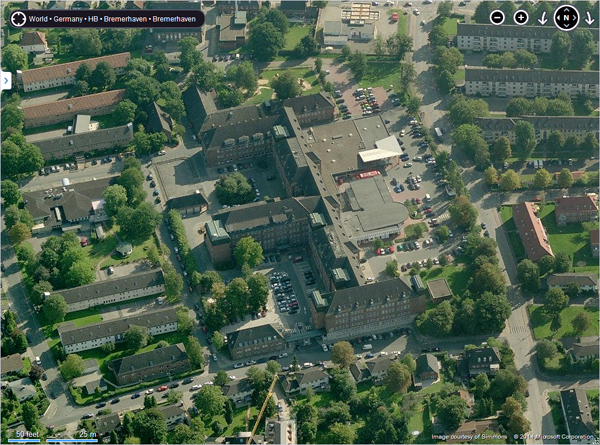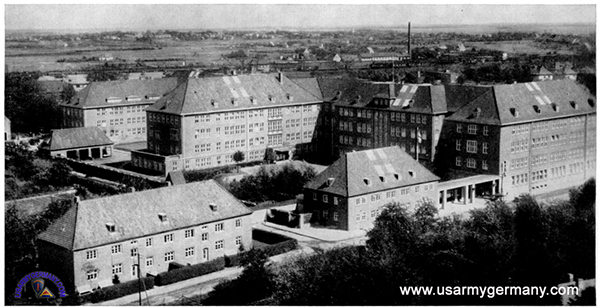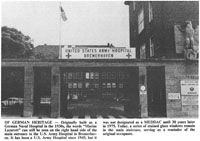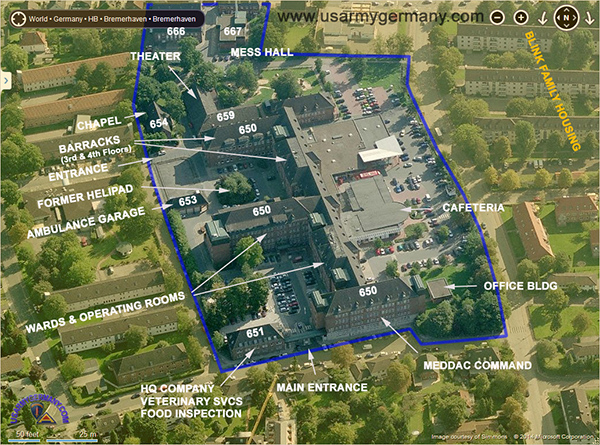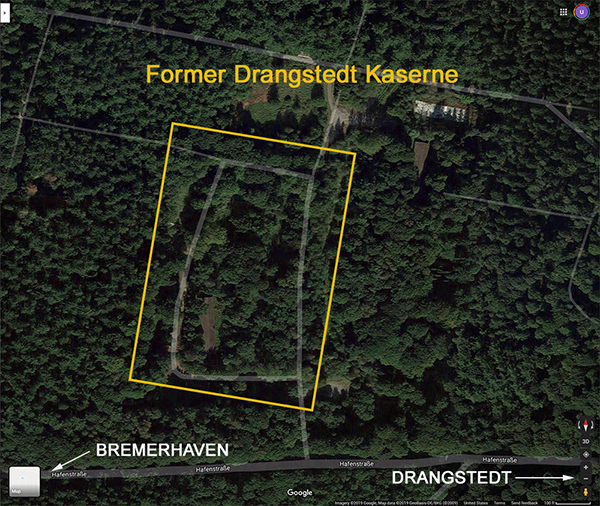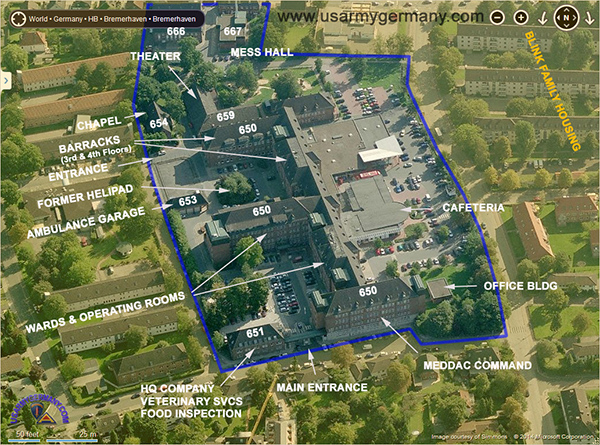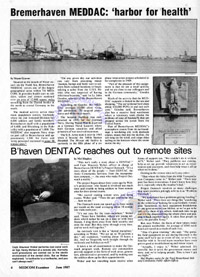| If you do
NOT see the Table of Contents frame to the left of this page, then
Click here to open 'USArmyGermany' frameset |
||||||||||||||||||||||||||||||||||||||||||||||||||||||||||||||||||||||||||||||||||||
|
USAH
Bremerhaven |
||||||||||||||||||||||||||||||||||||||||||||||||||||||||||||||||||||||||||||||||||||
|
|
||||||||||||||||||||||||||||||||||||||||||||||||||||||||||||||||||||||||||||||||||||
|
||||||||||||||||||||||||||||||||||||||||||||||||||||||||||||||||||||||||||||||||||||
|
|
||||||||||||||||||||||||||||||||||||||||||||||||||||||||||||||||||||||||||||||||||||
| 121st General Hospital | ||||||||||||||||||||||||||||||||||||||||||||||||||||||||||||||||||||||||||||||||||||
| (Source: EUCOM Medical Bulletin, Vol. 1, No. 3, October 1946, USAREUR History Office web site ) | ||||||||||||||||||||||||||||||||||||||||||||||||||||||||||||||||||||||||||||||||||||
| The 121st General Hospital at Bremerhaven, Germany, being located at the only port servicing United States Occupation Forces, assumes an unusual and interesting role. It occupies one of the finest hospital plants in Germany, completed in 1939 as a German Marine hospital. The buildings are of brick and concrete fire-proof construction, modern and beautifully finished. Necessary additions have been completed, including a neuropsychiatric section, a mess for patients, Red Cross facilities, a theater and a chapel, all of which facilitate the hospital's long term mission. The 121st continues to process an average of 600 patients each month for movement by hospital ship to the Zone of the Interior. Most of these patients were transferred by hospital train to the 121st from "boarding hospitals" throughout the occupied area. These cases represent a wide variety of interesting disease entities, offering invaluable material for observation and study -- an opportunity which is exploited through frequent clinical conferences. Patients continue to receive definitive treatment while awaiting embarkation, to permit their going aboard the hospital ship in the best possible condition for withstanding a ten-day or twelve-day voyage. Patients requiring immediate definitive care which is beyond the scope of occupation force hospitals, as well as those who are too ill to withstand the long boat trip, are evacuated to the United States by air, via Bremen, Germany, and Paris, France. In addition to its role as a holding hospital, the 121st General maintains an active pediatric service, children being admitted directly here from ships bringing dependents from the States. A fully equipped children's ward has been established and trained personnel provided for the care of these patients. The proximity of the troop staging and redeployment center, both male and female, as well as occupation units and personnel of the Navy and Merchant Marine provides his hospital with an active and varied patient census. The 121st General Hospital was activated 10 March 1944 at Camp Ellis, Illinois, and departed for overseas 22 July of the same year. The unit became operational as the 4111th US Army Hospital Plant under the 802nd Hospital Center on 2 September 1944, at Lufton Camp, Yeovil, Somerset, England, a former British infantry post. The hospital was closed on 4 May 1945, after eight months of successful operation at this site, and moved to Lesum Barracks, Bremen, Germany, by way of Southampton, Le Havre and the Maginot-Niel Medical Staging Camp, France, arriving 26 July 1945. Construction necessary for the conversion of the Lesum Barracks, a former German Ordnance Post, to a General Hospital plant was initiated on 20 June 1945, according to plans prepared by the Surgeon's and Engineer's Office , Bremen Post Command. On 3 December 1945, the unit moved to St. Joseph's Hospital, Bremen, Germany, relieving the 115th Evacuation Hospital, which formerly occupied this site, and began operations as the 4458th US Army Hospital Plant, rendering definitive medical care to the troops in the Bremen Area. A small number of officers and enlisted men remained at Lesum Barracks to supervise construction of the future home of the unit. In January 1946, upon deactivation of the 348th Station Hospital, the 121st General Hospital assumed operation of the 4457th US Army Hospital Plant located in the former Marine Lazarett, Bremerhaven, Germany. The new unit, designated Detachment "A", 121st General Hospital, served as a holding hospital for all patients being returned to the Zone of the Interior from the Theater, as well as caring for troops stationed in the Bremerhaven area. The 121st General Hospital moved from St. Joseph's Hospital, Bremen, Germany, to the Lesum plant on 25 April 1946 and Headquarters moved to Detachment "A" in Bremerhaven. A redesignation of the units was affected, the Lesum plant becoming Detachment "A", 121st General Hospital. The change was instituted because the greater patient and administrative load rested with the Bremerhaven plant. Since then, the two units of the 121st General Hospital have continued a mission that is among the most important of the tasks entrusted to the medical service in the European Theater. |
||||||||||||||||||||||||||||||||||||||||||||||||||||||||||||||||||||||||||||||||||||
| The Medicine Show (121st GH newspaper) - Some of the issues published while in Germany | ||||||||||||||||||||||||||||||||||||||||||||||||||||||||||||||||||||||||||||||||||||
| ISSUES IN COLLECTION | ||||||||||||||||||||||||||||||||||||||||||||||||||||||||||||||||||||||||||||||||||||
|
||||||||||||||||||||||||||||||||||||||||||||||||||||||||||||||||||||||||||||||||||||
| 319th Station Hospital | ||||||||||||||||||||||||||||||||||||||||||||||||||||||||||||||||||||||||||||||||||||
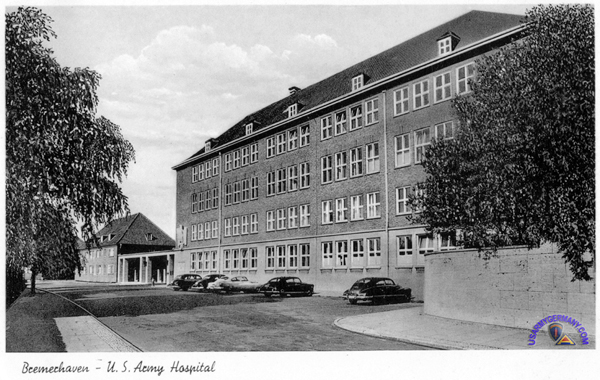 Looking towards the main entrance on Dr. Franz Mertens Strasse, 1950s |
||||||||||||||||||||||||||||||||||||||||||||||||||||||||||||||||||||||||||||||||||||
| (Source: EUCOM Medical Bulletin, Vol. 8, No. 4, April 1951, USAREUR History Office web site) | ||||||||||||||||||||||||||||||||||||||||||||||||||||||||||||||||||||||||||||||||||||
The 319th Station Hospital is located in Bremerhaven, Germany, and occupies the plant which was formerly a German Marine Lazarett.
|
||||||||||||||||||||||||||||||||||||||||||||||||||||||||||||||||||||||||||||||||||||
| Colonel Parrino has been the Commanding Officer of the 319th Station Hospital since 5 February 1950. | ||||||||||||||||||||||||||||||||||||||||||||||||||||||||||||||||||||||||||||||||||||
| 33rd Station Hospital | ||||||||||||||||||||||||||||||||||||||||||||||||||||||||||||||||||||||||||||||||||||
| The 33rd Station Hospital assumed operations at Bremerhaven in late 1954. (Source: MEDCOM Examiner, February 1982) In 1969, the 2nd Field Hosp took over operations. |
||||||||||||||||||||||||||||||||||||||||||||||||||||||||||||||||||||||||||||||||||||
| USAH Bremerhaven / Bremerhaven MEDDAC | ||||||||||||||||||||||||||||||||||||||||||||||||||||||||||||||||||||||||||||||||||||
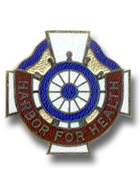 Bremerhaven MEDDAC DI Bremerhaven MEDDAC DI |
||||||||||||||||||||||||||||||||||||||||||||||||||||||||||||||||||||||||||||||||||||
| (Source: MEDCOM EXAMINER, February 1982) | ||||||||||||||||||||||||||||||||||||||||||||||||||||||||||||||||||||||||||||||||||||
| Bremerhaven MEDDAC: harbor for health By Ruth Hamill Editor's note: During the coming months the MEDCOM Examiner will feature each of the MEDCENs, MEDDACs and other MEDCOM treatment facilities in a series of articles designed to further acquaint people throughout 7th MEDCOM with the activity. The series begins this month, focusing on the Bremerhaven MEDDAC in Northern Germany. |
||||||||||||||||||||||||||||||||||||||||||||||||||||||||||||||||||||||||||||||||||||
|
||||||||||||||||||||||||||||||||||||||||||||||||||||||||||||||||||||||||||||||||||||
| Marine Lazarett Hospital construction began in the early 1930s during a period of extensive building in Germany prior to World War II. The hospital was officially opened in 1938 as a "Marine Lazarett" or German Naval Hospital. It was used temporarily by the British during their occupation of the Bremerhaven area, but was soon turned over to the U.S. Army forces under the command of Col. John Herman on June 28, 1945. The facility was designated as the 348th Station Hospital and remained under the command of various units for 25 years until 1969 when it was upgraded to a Field Hospital. In 1975 the facility was officially designated as the U.S. Army Medical Department Activity (MEDDAC), Bremerhaven. Today the MEDDAC is composed of the U.S. Army Hospital, the U.S. Army Dental Activity (DENTAC) and the 21st Medical Detachment (Veterinary Services.) The large, four-story, E-shaped hospital is constructed of fireproof materials and concrete with marble floors and walls. The main staircase has a series of stained glass windows which portray maritime scenes reflecting the heritage of the hospital's original occupants. With the exception of some remodeling projects, such as the new dental clinic which opened Sept. 28, the building itself has not changed much. The services and personnel, however, have expanded greatly over the years. More than 320 people are on the hospital staff, including 67 officers, (14 of which are doctors) and 170 enlisted people, according to 1st Lt. Candace Tormey, adjutant. There is also one doctor who is a DA civilian and one who is a local national. In addition to general medical care the MEDDAC offers specialties such as general surgery, internal medicine, obstetrics and gynecology, family practice, optometry and social work services. In the last two years the following specialties have been added or expanded: orthopedics, psychiatry, psycnology, radiology and pediatrics. New orthopedic department Capt. Larry L. Josie, chief of Patient Administration for the hospital, said that. they have an operating capacity of 51 beds with an average of 20 occupied at any one time. There are between 130 and 170 admissions per month and he feels this number will increase because of the new orthopedic department. He said, "Patients receiving orthopedic care will be admitted to our hospital instead of going elsewhere for treatment" There are more than 5000 clinic visits per month and the hospital currently maintains 8000, outpatients records. Medical conditions that cannot be treated at the hospital are referred to German physicians or are sent to the Frankfurt or Landstuhl. Medical Centers. Davis said, "Because we are relatively isolated we must work closely with and depend on the German civilian physicians in our community. Lt. Col. Mike Hinton, executive officer, added, "We also have a very close working relationship with the 159th Aviation Unit in Garlstedt due to our unusually large geographical area of patient responsibility. The 159th brings patients to Bremerhaven from Norddeutschland's outlying areas or moves them to Frankfurt or another of the larger military hospitals." He continued, "I consider this a small town hospital, but with better staffing and facilities I believe the military community is very pleased with the medical care they receive. Our workload permits the extra care and attention which often separates satisfaction from dissatisfaction. Patient satisfaction is completely different from patient care. A patient may receive excellent medical care and still not be satisfied." The hospital building complex also houses the 21st Medical Detachment (Veterinary Services). Under the supervision of Maj. Bennie Rice, Jr., commander, 16 soldiers and one local national are responsible for veterinary food inspections for the NDL Military Communities. They are nearly always on the road inspecting potatoes, eggs, dairy products, beef, pork and other foods at slaughter houses, commercial establishments, the Cold Storage Depot, Troop Subsistence Activity, Commissaries and Foodlands. Rice said, "All food destined for use by the military originating or passing through Norddeutschland must be inspected. Due to an increase in Army procurement our workload tripled last year and we inspected about 150 million pounds of food." The 21st Medical Detachment also has an animal technician who maintains the Zoonosis Animal Disease Prevention and Control Facility (which offers treatment for diseases transmittable between animals and man), administers rabies and distempter immunizations and performs other veterinary duties. Although the Bremerhaven MEDDAC is the smallest in Germany it has the largest area to support, according to SSgt. Roger Keathley, NCOIC of Patient Administration. In spite of the responsibility of the mission Keathley agreed with Davis and many others when he said, "Because the relationship between the enlisted and the professional staff at the hospital is so good we have very high morale and it makes Bremerhaven a great place to work." |
||||||||||||||||||||||||||||||||||||||||||||||||||||||||||||||||||||||||||||||||||||
| If you have more
information on the history or organization of the Bremerhaven Army Hospital, please contact me |
||||||||||||||||||||||||||||||||||||||||||||||||||||||||||||||||||||||||||||||||||||
1978 |
||||||||||||||||||||||||||||||||||||||||||||||||||||||||||||||||||||||||||||||||||||
(Source: STARS & STRIPES, April 10 1978) |
||||||||||||||||||||||||||||||||||||||||||||||||||||||||||||||||||||||||||||||||||||
Modernization plans for US Army Hospital Bremerhaven |
||||||||||||||||||||||||||||||||||||||||||||||||||||||||||||||||||||||||||||||||||||
| 1981 | ||||||||||||||||||||||||||||||||||||||||||||||||||||||||||||||||||||||||||||||||||||
| (Source: Email from Deanna Deville) | ||||||||||||||||||||||||||||||||||||||||||||||||||||||||||||||||||||||||||||||||||||
| I stumbled across this website and this article on the Bremerhaven MEDDAC. I was stationed there from January 1981 through July 1982, and knew most of the folks mentioned in the article. Your article at the end says to contact you if you have more information. I was there when the new orthopedic surgeon arrived and began to build up the orthopedics practice there. The hospital was returned to the German government after the tearing down of the Berlin wall. I imagine that occurred in the mid ‘90s. I also worked at 7th Medical Command from 1988 to 1990. It was situated on Nachrichten Kaserne, which is where the Heidelberg hospital was located. I remember that while I was there, Landstuhl installed their first MRI. Their new facility construction had recently been completed, and like many other Army hospitals, was embracing the new MRI technology. In 1990, I moved to the Nuernberg MEDDAC. We had a CT scanner, but no MRI. I couldn't say, but perhaps Frankfurt had an MRI as well. At the time, I believe Frankfurt was larger than Landstuhl. Right after I arrived at Nuernberg, Iraq invaded Kuwait. At Nuernberg, we reconfigured the hospital to create more bed space in the event of high casualties during Desert Storm. Offices were cleared out to make room for patient beds. This was the standard plan for mobilization. At Nuernberg, sick call services were moved to Merrell Barracks across town, and we even installed a deployable X-ray system. Merrell Barracks was the home of 2nd ACR (Armored Cavalry Regiment), and as they had been deployed to Saudi around Thanksgiving of 1990, we were able to re-utilize the space. Of course, we were all very glad that there were so few patients. Our casualty rate was very low during Desert Storm (and of course, OIF as well). I left Nuernberg in 1992, and I know that shortly thereafter they began to close it down to return it to the German government. Even before I left, they weren't filling slots for senior officers as they rotated back to the States. They just put the captains and majors who were there into lieutenant colonel and colonel slots. I found a reference that says Nuernberg closed 15 June 1994; that would be about right (http://www.nbg-mil-com.de/Hospital/ho.html). I remember listening to AFN as they announced the huge troop withdrawals from Europe. This was occurring in early 1991, while troops were still deployed to Saudi Arabia, before Desert Storm kicked off. They would list the units that were redeploying to the States, reading off battalion after battalion, and it would take forever to get through the list, or so it seemed. The announcer would just read and read, and then read some more. It was amazing. Wuerzburg took over the regional medical care mission for the remaining Nuernberg hospital catchment area. A Google search reveals a couple of articles that say the final retreat at Wuerzburg was held on 19 Oct 2007 and that the hospital closed 22 Oct 2007 (http://www.army.mil/article/5878/wuerzburg-hospital-sounds-final-retreat). According to Wikipedia, Nachrichten Kaserne in Heidelberg is scheduled to close in 2015 (http://en.wikipedia.org/wiki/List_of_United_States_Army_installations_in_Germany). That would mean the hospital there will be closed, if it isn't gone already. Patton died there. One of the rooms on the ground floor had a plaque as an historical marker. Another article (http://en.wikipedia.org/wiki/United_States_Army_Garrison_Heidelberg) says the hospital there has been downgraded to "Health Center". That's a new term to me (laughing). I don't know if this information is important to you or not. It was fun reminiscing, though. I had good times over there. |
||||||||||||||||||||||||||||||||||||||||||||||||||||||||||||||||||||||||||||||||||||
| (Source: Email from Craig Carpenter) | ||||||||||||||||||||||||||||||||||||||||||||||||||||||||||||||||||||||||||||||||||||
| I was there from about 1981 to 1983 and left barely before they were moving everyone out of the barracks for the reconstruction.
I was also there when the first orthopedic surgeon showed up. One day not long after he arrived his wife arrived and that same day I was working in the recovery room with a cast to my arm pit for a navicular break, which the orthopedic surgeon had casted with no surgery. Anyway a guy came in, one of us no less, who had jumped out a second or third floor window because he was so drunk landed on his hands and knees with only badly broken navicular bones in both wrists. So we were in there with our casts on and the doc comes in with his wife and says: "Ahh, here are my two navicular patients all in one place." Or something to that effect. I found an aerial view (see above) and marked it up with what I can remember, though I might be wrong on some of that – especially the new stuff. It was a long time ago… For the first couple of years after I arrived in early 1981, I had two roommates, Alberto Rios from NYC, and Frederick M. Rice the third from Bangor Maine, both OR techs. Don’t ask me to remember anyone else, for now anyway. One time I came back from the day shift on the med/surge ward, it was a Saturday and there was a keg of Germany’s finest brew sitting on my desk. Along with the beer were a few no longer sober barracks mates getting ready for a Grateful Dead concert down in Bremen. They had already begun the arduous task of face painting… it wouldn’t be polite to arrive with a clear mind and clear complexion to a Dead concert. After a few hours of painting and drinking we headed down the autobahn and right into a ginormous crowd of well healed tux and gown wearing genteel folk. Not the Dead horde we had anticipated. After more than a few minutes of panic filled glares at our degenerate posse we pronounced this was probably not the proper venue. As we journeyed gleefully incognito to track down our Dead kin in an adjacent Halle, we knew with certainty we had had our moment of fame. After fighting our way to more familiar territory the alter of the Dead appeared and the great Jerry himself stood front and center. Pushing our way forward for a commanding view, our gang had a great time. Then we returned home with deadly hangovers, ringing ears, and face paint to remove on a quiet Sunday morning. |
||||||||||||||||||||||||||||||||||||||||||||||||||||||||||||||||||||||||||||||||||||
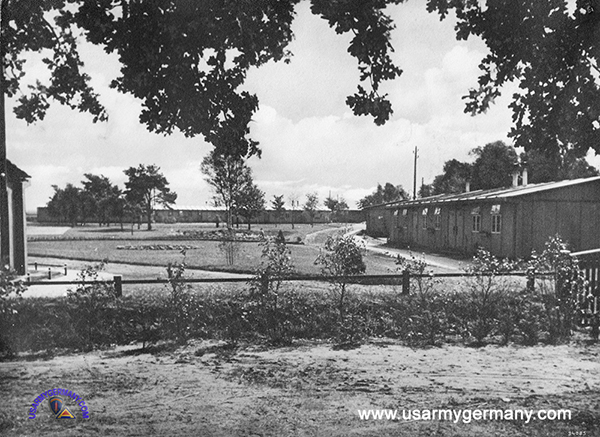 WWII-era photo of the German kaserne at Drangstedt (German postcard) |
||||||||||||||||||||||||||||||||||||||||||||||||||||||||||||||||||||||||||||||||||||
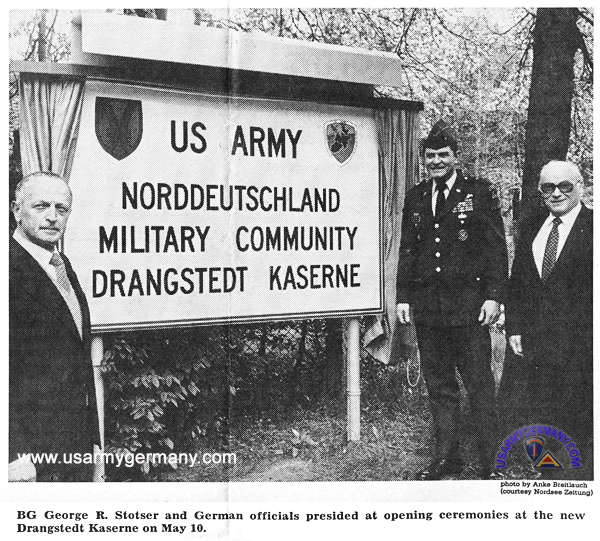 May 10 1983, opening ceremonies (Webmaster's collection) |
||||||||||||||||||||||||||||||||||||||||||||||||||||||||||||||||||||||||||||||||||||
| 1982 | ||||||||||||||||||||||||||||||||||||||||||||||||||||||||||||||||||||||||||||||||||||
| (Source: Email from Tedd Hale) | ||||||||||||||||||||||||||||||||||||||||||||||||||||||||||||||||||||||||||||||||||||
I was stationed at the US Army Hospital in Bremerhaven from May 1982 - Feb 1984. |
||||||||||||||||||||||||||||||||||||||||||||||||||||||||||||||||||||||||||||||||||||
Hospital Compound |
||||||||||||||||||||||||||||||||||||||||||||||||||||||||||||||||||||||||||||||||||||
| 1987 | ||||||||||||||||||||||||||||||||||||||||||||||||||||||||||||||||||||||||||||||||||||
| (Source: MEDCOM EXAMINER, June 1987) | ||||||||||||||||||||||||||||||||||||||||||||||||||||||||||||||||||||||||||||||||||||
|
||||||||||||||||||||||||||||||||||||||||||||||||||||||||||||||||||||||||||||||||||||
| Related Links: |
||||||||||||||||||||||||||||||||||||||||||||||||||||||||||||||||||||||||||||||||||||

